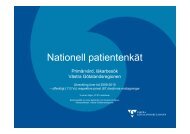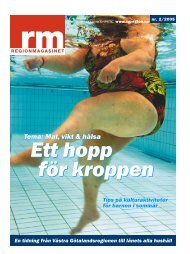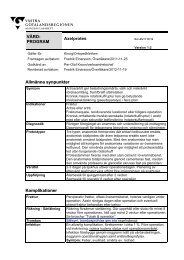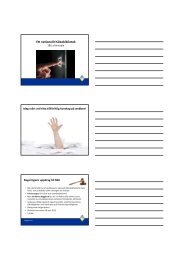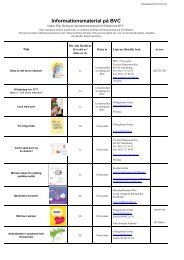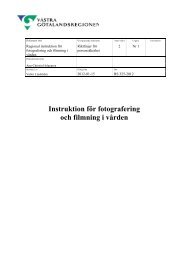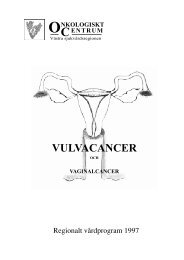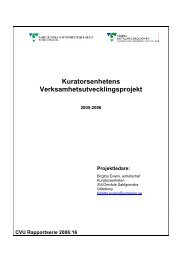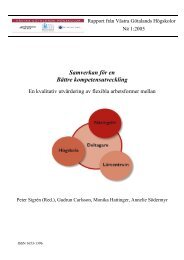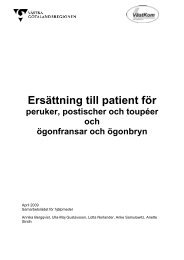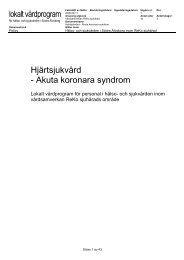FOURTEENTH ANNUAL EUROPEAN PRESSURE ULCER ...
FOURTEENTH ANNUAL EUROPEAN PRESSURE ULCER ...
FOURTEENTH ANNUAL EUROPEAN PRESSURE ULCER ...
You also want an ePaper? Increase the reach of your titles
YUMPU automatically turns print PDFs into web optimized ePapers that Google loves.
Thursday September 1st<br />
Proceedings of the 14th Annual European Pressure Ulcer Meeting<br />
Oporto, Portugal<br />
With or without a risk assessment scale? An evaluation of the impact of the Braden Scale on<br />
allocation of preventive interventions to traumatological patients<br />
Sylvia Mallison 1 , Laura Kremer 1 , Anne Junghans 1 , Katrin Balzer 1<br />
1 Institute for Social Medicine, Universität zu Lübeck, Germany, katrin.balzer@uk-sh.de<br />
Introduction<br />
Traumatological patients are exposed to increased<br />
pressure ulcer (PU) risk but seem to be systematically<br />
under-supplied with preventive measures [1]. To date<br />
the evidence whether use of a pressure ulcer risk<br />
assessment scale (PURAS) improves PU preventive<br />
care in hospital patients is lacking [2]. Therefore,<br />
following research question was investigated: Does<br />
routine use of the Braden Scale (BS), one of the<br />
widespread PURASs in German hospitals, increase<br />
the number of traumatological patients at high PU risk<br />
receiving adequate preventive measures?<br />
Methods<br />
A quasi-experimental study was conducted in 2<br />
independent traumatological wards at one university<br />
hospital. In ward A, nurses regularly used the BS<br />
along to their clinical judgement over a period of 6<br />
months (intervention periods 1+2). In ward B, for 3<br />
months nurses appraised patients’ PU risk based on<br />
their clinical judgement alone (intervention period 1).<br />
They were asked to regularly document their<br />
assessment result by means of a four step global<br />
judgment scale. After this period, nurses in ward B<br />
also used the BS along to their clinical judgement<br />
(intervention period 2) (Fig. 1).<br />
Fig. 1: The trial setup. (*assessment of current state of<br />
preventive practice, **Training in use of Braden Scale before<br />
start of intervention phase 2, mo=months)<br />
Patients aged ≥18 years, not suffering from PU >grade<br />
1 and having an expected length of hospital stay ≥5<br />
days were eligible for consecutive inclusion.<br />
Data were collected by trained study assistants who<br />
regularly observed patients for presence of risk<br />
factors, preventive interventions and PU. Primary<br />
endpoint was presence of adequate preventive<br />
measures when patients were noted to be at high PU<br />
risk for the first time during follow-up as assessed by<br />
study assistants. Prevention was considered adequate<br />
85<br />
if patients at high risk received two pressure-relieving<br />
interventions at least, e.g., repositioning, pressureredistributing<br />
support surface, or offload of the heels.<br />
Results<br />
In total, 571 patients were included, with 377 being<br />
assessed at high PU risk (232 in intervention periods 1<br />
or 2). Univariate analysis revealed non-significant<br />
differences between study groups in the primary<br />
endpoint. However, these differences are inconsistent<br />
in direction and size of impact of BS (Tab. 1).<br />
Table 1: Univariate results for primary endpoint<br />
Patients with ≥2<br />
pressure-relieving<br />
measures (%)<br />
Ward A: periods<br />
27 (27 %)<br />
1+2 (BS) n=100)<br />
Ward B: period 1<br />
19 (25 %)<br />
(GJ) (n=76)<br />
Ward B: period 2<br />
8 (15 %)<br />
(BS) (n=55)<br />
BS=Braden Scale, GJ=Global Judgement<br />
Odds Ratio (95 CI)<br />
Inter-group Intra-group<br />
1,11<br />
(0,21-2,19)<br />
0,51<br />
(0,21-1,27)<br />
Discussion<br />
Use of the BS seems to have had no clear-cut effect<br />
on allocation of preventive measures to patients at<br />
high PU risk in this trial. Further analyses are required<br />
to control for the impact of baseline differences<br />
between study groups. Explorative analyses are<br />
planned to identify clinical characteristics of patients<br />
whose risk is likely to be overseen and to assess the<br />
impact of sub-adequate prevention on PU incidence.<br />
Clinical relevance<br />
Results from awaiting trial analyses are expected to<br />
reveal critical issues for improving nurses’ PU risk<br />
assessment and preventive care in traumatological<br />
patients.<br />
Conflict of Interest<br />
This trial was funded by a grant of the foundation<br />
B. Braun Stiftung. The funding source had no role in<br />
design and conduct of the study. All authors declare<br />
that they have no conflict of interest.<br />
References<br />
[1] Baumgarten M. et al., Gerontologist. 50: 253-262,<br />
2010<br />
[2] Kottner J. et al., J Multidiscip Healthc 3:103-111,<br />
2010.<br />
Copyright © 2011 by EPUAP



